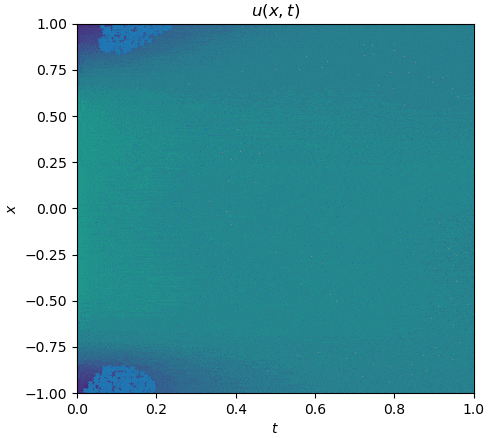4.3 KiB
Allen-Cahn Equation
This section repeats the adaptive PINN method presented by Wight and Zhao.
The Allen-Cahn equation has the following general form:
\partial_{t} u=\gamma_{1} \Delta u+\gamma_{2}\left(u-u^{3}\right). Consider the one-dimensional Allen-Cahn equation with periodic boundary conditions:
\begin{array}{l}
u_{t}-0.0001 u_{x x}+5 u^{3}-5 u=0, \quad x \in[-1,1], \quad t \in[0,1], \\
u(0, x)=x^{2} \cos (\pi x) \\
u(t,-1)=u(t, 1) \\
u_{x}(t,-1)=u_{x}(t, 1).
\end{array}
Periodic Boundary Conditions
The periodic boundary conditions are enforced by u(t, x)=u(t,x+2) and u_x(t, x)=u_x(t,x+2) with x=-1, which is
equivalent to
\begin{array}{l}
\tilde u(t,x)=u(t,x+2), \quad \forall t\in[0,1],x\in[-1,1], \\
\tilde u(t,x)=u(t,x),\quad \forall t\in[0,1],x=-1, \\
\tilde u_x(t,x)=u_x(t,x),\quad \forall t\in[0,1],x=-1.\\
\end{array}
The transform above is implemented by
net_u = sc.MLP([2, 128, 128, 128, 128, 2], activation=sc.Activation.tanh)
net_u = sc.NetNode(inputs=('x', 't',), outputs=('u',), name='net1', net=net_u)
xp = sc.ExpressionNode(name='xp', expression=x + 2)
net_tilde_u = sc.get_shared_net_node(net_u, inputs=('xp', 't',), outputs=('up',), name='net2', arch='mlp')
where xp translates x to x+2. The node net_tilde_u has the same internal parameters as net_u while its inputs
and outputs are translated.
Receivers acting as Callbacks
We define a group of Signal to trigger receivers.
They are adequate for customizing various PINN algorithms at the moment.
class Signal(Enum):
REGISTER = 'signal_register'
SOLVE_START = 'signal_solve_start'
TRAIN_PIPE_START = 'signal_train_pipe_start'
AFTER_COMPUTE_LOSS = 'compute_loss'
BEFORE_BACKWARD = 'signal_before_backward'
TRAIN_PIPE_END = 'signal_train_pipe_end'
SOLVE_END = 'signal_solve_end'
We implement the adaptive sampling method as follows.
class SpaceAdaptiveReceiver(sc.Receiver):
# implement the abstract method in sc.Receiver
def receive_notify(self, solver, message):
# In each iteration, after the train pipe ends, the receiver will be notified.
# Every five 500 iterations, the adaptive sampling will be triggerd.
if sc.Signal.TRAIN_PIPE_END in message.keys() and solver.global_step % 1000 == 0:
sc.logger.info('space adaptive sampling...')
# Do extra sampling and compute the residual
results = solver.infer_step({'data_evaluate': ['x', 't', 'sdf', 'AllenCahn_u']})
residual_data = results['data_evaluate']['AllenCahn_u'].detach().cpu().numpy().ravel()
# Sort the points by residual loss
index = np.argsort(-1. * np.abs(residual_data))[:200]
_points = {key: values[index].detach().cpu().numpy() for key, values in results['data_evaluate'].items()}
_points.pop('AllenCahn_u')
_points['area'] = np.zeros_like(_points['sdf']) + (1.0 / 200)
# Update the points in the re_samping_domain
solver.set_domain_parameter('re_sampling_domain', {'points': _points})
We also draw the result every 1000 iterations.
class PostProcessReceiver(Receiver):
def receive_notify(self, solver, message):
if pinnnet.receivers.Signal.TRAIN_PIPE_END in message.keys() and solver.global_step % 1000 == 1:
points = s.infer_step({'allen_test': ['x', 't', 'u']})
triang_total = tri.Triangulation(points['allen_test']['t'].detach().cpu().numpy().ravel(),
points['allen_test']['x'].detach().cpu().numpy().ravel(), )
plt.tricontourf(triang_total, points['allen_test']['u'].detach().cpu().numpy().ravel(), 100)
tc_bar = plt.colorbar()
tc_bar.ax.tick_params(labelsize=12)
plt.xlabel('$t$')
plt.ylabel('$x$')
plt.title('$u(x,t)$')
plt.savefig(f'result_{solver.global_step}.png')
plt.show()
Before Solver.solve() is called, register the two receivers to the solver:
s.register_receiver(SpaceAdaptiveReceiver())
s.register_receiver(PostProcessReceiver())
The training process is shown as follows:
See examples/allen_cahn.
